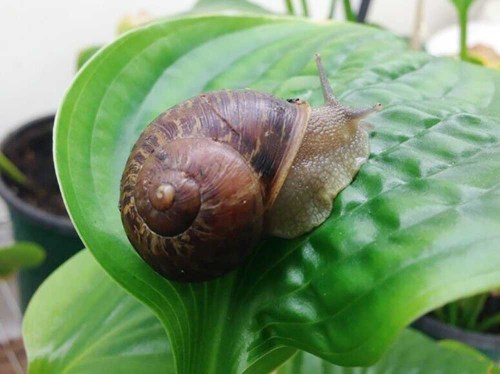Western Innovator: On the trail of invasive slugs and snails
Published 11:15 am Friday, December 9, 2022

- The European brown garden snail is one of several invasive gastropod species that can cause significant crop damage on farms across the Northwest.
CORVALLIS, Ore. — Rory McDonnell’s fascination with slugs and snails began as a child growing up in the Irish countryside.
When they weren’t in school, McDonnell and his brother could often be found outdoors catching tadpoles, beetles and other aquatic invertebrates, which they would keep in small handmade aquariums fashioned out of plastic candy containers.
Trending
“I have very fond memories of that part of my life,” said McDonnell, now an associate professor at Oregon State University. “We were pretty geeky kids, to be honest, but it was fun.”
McDonnell was especially captivated by slugs and snails after reading more about them in nature books — how they have more teeth than a shark, or how they can crawl over broken glass, or how each individual has both male and female reproductive parts.
The gastropods are also a slimy, invasive pest for Northwest farms, feasting on a wide variety of crops and causing tens of millions of dollars worth of damage every year.
Since coming to OSU in 2016, McDonnell has established the only university research program in North America entirely focused on helping growers manage slugs and snails without overly relying on conventional chemical pellets.
One novel solution that has recently come out of McDonnell’s lab involves using bread dough as an attractant. Field trials in Oregon, Hawaii and Montana have repeatedly demonstrated that bread dough can be an effective bait for slugs and snails.
“This could be an important (tool), not just in the Pacific Northwest but in developing countries where they don’t have the resources to purchase chemical pesticides,” McDonnell said.
Trending
Invasive pests
To be clear, the Northwest is home to native slugs and snails, though McDonnell said they tend not to be found in agricultural systems.
These native species mostly live in forests where they play an important ecological function, helping to break down nutrients in soil and providing a source of food for other animals, including birds, snakes and small mammals.
Rather, it is the invasive species — the gray field slug, European brown garden snail and white-soled slug, to name a few — that cause farmers headaches, McDonnell said.
In the grass seed industry alone, exotic slugs and snails cause an estimated $60 million in crop damage every year. The pests are also voracious eaters of fruits, vegetables and grains.
“They are, without question, one of our most important pests,” McDonnell said. “They feed on a huge range of crops.”
More invaders could be on the way, McDonnell added.
Though primarily a subtropical species, the giant African land snail has demonstrated enough cold tolerance to thrive in the Northwest. Eastern heath snails, originally from Europe, have taken hold in Montana, and could pose a major threat to wheat if they arrive in the Northwest.
The purpose of McDonell’s research is to be proactive and develop effective treatments while there’s still time.
“We don’t want to wait for something to get here and then panic,” he said. “We’re better off having something ready to go when we realize it’s here.”
Bake and bait
In his lab at OSU, McDonnell has experimented with several novel attractants for slugs and snails.
Strawberries, citrus and cucumber were all tried, with varying degrees of success. So too was beer, another popular remedy for home gardeners. The idea is that slugs and snails are attracted by the yeasty smell of beer.
That got McDonnell thinking, was there another fermented product he could try?
“Bread was just an obvious choice,” he said.
Initial lab tests showed promise, prompting McDonnell and his team to take his hypothesis in the field.
They set up their first experiment in May 2018 near Newport, Ore., where they caught about 100 European brown garden snails in traps baited with bread dough versus one in a control trap baited with water.
A second trial was equally successful, catching hundreds of gray field slugs at a farm growing white clover in the Mid-Willamette Valley.
Synthesizing smell
Bread dough was also effective catching giant African land snails in Hawaii, and worked like gangbusters on Eastern heath snails in Montana, nabbing 18,000 of the dime-sized pests.
“We know this bread dough is highly attractive to a wide range of gastropod species,” McDonnell said.
Not only does it work, but the dough lasts up to eight days in the field, he added. The team is now working with a chemist in Canada to determine if they can synthesize the smell, so it can be incorporated into existing baits and pellets.
Project collaborators include the USDA, Montana Department of Agriculture, University of Hawaii and University of California-Riverside.
When it comes to slugs and snails, McDonnell said the number of tools that growers have to manage and control them is a lot lower than for other insect pests.
Chemical baits are not always consistent, and while tilling soil can be beneficial, more farmers are adopting no-till practices to prevent erosion and loss of organic matter. On the other hand, traps and barriers might not be practical for large-acreage farms.
“The more tools you have, the better chance you have of managing slugs and snails,” McDonnell said.
Age: 46
Occupation: Associate professor, Oregon State University
Hometown: Corvallis, Ore.
Education: Bachelor’s degree in environmental science, National University of Ireland; doctorate in applied ecology, National University of Ireland
Family: Wife, Veronica, and two children









